Long Range Bowhunting
By Lorenzo Young
 The waiting is the hard part for me. Always has been. Yet, I knew I had to move slowly. Painstakingly I examined the steep hillside again. I stood in the shadows of a small band of dark pines. I was on a narrow ridge in a high crisp alpine basin. The setting sun was pushing long cool shadows across the clearing ahead. I eased forward another foot, and waited while my hair turned grey.
The waiting is the hard part for me. Always has been. Yet, I knew I had to move slowly. Painstakingly I examined the steep hillside again. I stood in the shadows of a small band of dark pines. I was on a narrow ridge in a high crisp alpine basin. The setting sun was pushing long cool shadows across the clearing ahead. I eased forward another foot, and waited while my hair turned grey.
I was sure the deer were close. I'd watched the deer fade into the little clump of pines several times. I figured they were here now. Bringing my binoculars up I searched the shadows again. A slight sound brought my attention to a small rock trickling downhill. Retracing the flight of the rock, I saw a deer stand and begin to feed. The deer was on the other side of the small clearing, quartering steeply away.
I waited anxiously as the deer fed for a glimpse of his antlers. A long, quiet minute passed before the deer looked down the canyon, exposing deep velvet covered tines. Deciding I'd seen enough, I brought up my rangefinder. Seventy eight yards the rangefinder said, with a corrected yardage of seventy four and a half for the incline. Carefully, I shifted my feet for a solid stance.
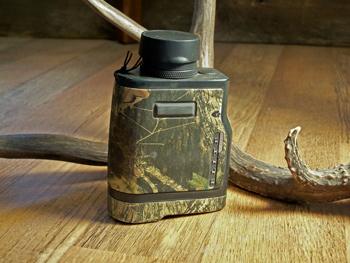
Finding my anchor, I took a couple of slow deep breaths. As the pin settled, I checked my cant and my grip. Just like practice, I told myself. Focusing on a smooth release, I was pleased when the shot broke. Perfect! As the arrow arched high, the deer looked my way. For a brief moment the blue fletching flashed brightly as it slipped through his rust n' tan hide. Beautiful shot! I found him on the other side of a low ridge. He'd gone fifty, sixty yards. Once again, I was impressed with the efficiency of a bow.
Seventy-eight yards! I can see the frowns and furrowed brows. It used to be such a shot was a risky thing. Today, we have the equipment to make such ranges comfortable. Let's take a look at what went into making this shot. Let's look at the gear, the skill, and the considerations, unique to long range bowhunting. Then, let's take a peak at how friends of mine are stretching their limits to ranges you won't believe.
Gear
Shooting longer ranges requires some special equipment. It also requires we choose our gear to meet certain requirements. I'll outline what I look for in a bow. Then, discuss how I choose the accessories to help the bow perform. Finally, we'll look at rangefinders, a critical piece of gear.
Bow
For our purpose, we need a bow that's accurate, fast, and quiet. I also want what I consider to be a friendly bow. Let's start with a quality piece of equipment. Chances are we won't get the job done with a low priced package "deal".
When choosing an accurate bow, I start with feel every time. I want a bow that feels natural! I want it to become an extension of my arm. Draw length is critical. I get a bow as close as I can, than experiment with an adjustable length release aid. I also want a comfortable grip, and forgiving brace height. A bow with these qualities is a recipe for accuracy.
While I consider speed secondary to accuracy, it is our next limiting factor. Simply put, we need to choose one of the faster bows. Mathews Drenalin, PSE X Force, and Hoyt's Vectrix are good examples.
One of the most common arguments against long range bowhunting is animals have plenty of time to jump the string. Or, move out of the way of the arrow before it arrives, resulting in a poor hit. My personal experience has been animals at close ranges react violently to the sound of the shot. Animals past about forty yards react much less. While animals at long range often simply look up. I am convinced a quiet bow alarms animals much less.
Finally, I want a friendly bow. I shoot a Mathews Switchback. The bow has a comfortable grip, smooth draw, and a solid back wall. The bow also has a forgiving brace height. This helps mute minor shooting flaws. The bow is also very quiet, with little shock transferred to my hand. It is also an easy bow to tune. In short, it is extremely comfortable, easy to set up, and easy to shoot. Like a fine woman, this bow's a pleasure to handle!
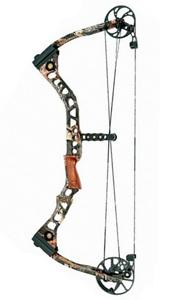
Bow Accessories
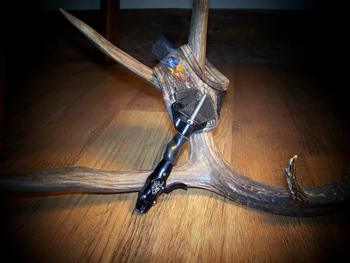
The theme is quality. You need accessories that are accurate, rugged, and reliable. There are few things more frustrating than a stretching string, sticky rest, or a sight that slips. Save yourself a lot of headache, start with the best. I'd have less grey hair if I had!
Rangefinder
The other part of the long range equation is the range finder. We simply cannot shoot long range without one. I have tried several, and currently use the Bushnell elite 1500 ARC. The first requirement is to have a bright enough optic to use at twilight, and in the dark timber. Our rangefinder must also measure and compensate for slope. This critical feature vastly narrows our options when choosing a rangefinder.
Practice
We now have a fine bow, handy rangefinder, empty wallet, scowling wife, and lonely girlfriend. Now what? Practice. This is good news! Practice is fun. Let's start out taking it easy and just getting a feel for the bow. Just relax and have a little fun. Once we've got a feel for the gear and have shot a couple hundred arrows, everything should be broken in. It's time for a trip to the pro shop to get everything tuned properly. Do not skip this step!
The main thing here is to enjoy the journey. The shooting skill required to shoot far will only come with time and practice. There's a lot of info readily available on the fundamentals of archery shooting. I'm going to cover a few of the keys I have found most critical. I'll also share some tips, and ideas I've found useful.
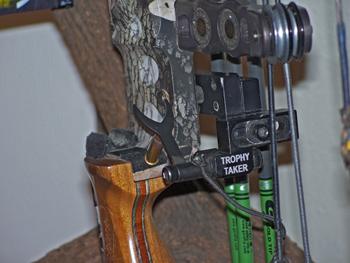
Now, let's discuss a few tips and ideas that'll make us more effective in the field.
Consider This
We have access to some awesome equipment! While I'm advocating maximizing the abilities of our gear, let us not forget the limitations. Our gear has limitations, our skill has limitations, and conditions are limiting factors. Wild animals suffer brutal deaths. They die of starvation, exposure, and being eaten. Still, I wouldn't like to think this article led to careless shooting and needless suffering. I'd like to talk about some of the things we must consider when sizing up a long shot in the field
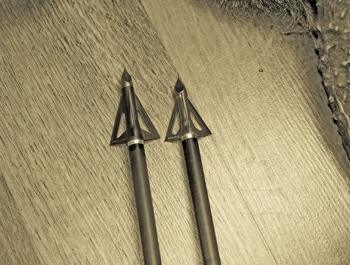
Extreme Range!
I consider my max range ninety yards. I simply ran out of room for pins! Also, while I shoot a relatively fast bow I'm not confident I'll get sufficient penetration much further. I'm also at the outer edge of my accuracy range. I have a group of friends who shoot and take game significantly further. These guys set up especially for extreme range.
I'll tell you about how they have stretched the limits to amazing distances.
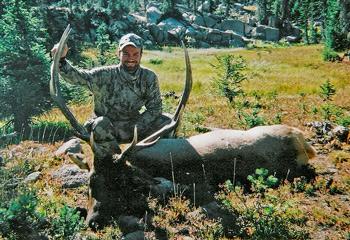
Good Luck!
There is a world full of people who say things couldn't or shouldn't be done. The limits of yesterday are not easily forgotten. For those willing to invest in quality gear and to develop above average shooting skill, there is another world beyond the top pin! Good luck and good hunting!
By Lorenzo Young

I was sure the deer were close. I'd watched the deer fade into the little clump of pines several times. I figured they were here now. Bringing my binoculars up I searched the shadows again. A slight sound brought my attention to a small rock trickling downhill. Retracing the flight of the rock, I saw a deer stand and begin to feed. The deer was on the other side of the small clearing, quartering steeply away.
I waited anxiously as the deer fed for a glimpse of his antlers. A long, quiet minute passed before the deer looked down the canyon, exposing deep velvet covered tines. Deciding I'd seen enough, I brought up my rangefinder. Seventy eight yards the rangefinder said, with a corrected yardage of seventy four and a half for the incline. Carefully, I shifted my feet for a solid stance.

Finding my anchor, I took a couple of slow deep breaths. As the pin settled, I checked my cant and my grip. Just like practice, I told myself. Focusing on a smooth release, I was pleased when the shot broke. Perfect! As the arrow arched high, the deer looked my way. For a brief moment the blue fletching flashed brightly as it slipped through his rust n' tan hide. Beautiful shot! I found him on the other side of a low ridge. He'd gone fifty, sixty yards. Once again, I was impressed with the efficiency of a bow.
Seventy-eight yards! I can see the frowns and furrowed brows. It used to be such a shot was a risky thing. Today, we have the equipment to make such ranges comfortable. Let's take a look at what went into making this shot. Let's look at the gear, the skill, and the considerations, unique to long range bowhunting. Then, let's take a peak at how friends of mine are stretching their limits to ranges you won't believe.
Gear
Shooting longer ranges requires some special equipment. It also requires we choose our gear to meet certain requirements. I'll outline what I look for in a bow. Then, discuss how I choose the accessories to help the bow perform. Finally, we'll look at rangefinders, a critical piece of gear.
Bow
For our purpose, we need a bow that's accurate, fast, and quiet. I also want what I consider to be a friendly bow. Let's start with a quality piece of equipment. Chances are we won't get the job done with a low priced package "deal".
When choosing an accurate bow, I start with feel every time. I want a bow that feels natural! I want it to become an extension of my arm. Draw length is critical. I get a bow as close as I can, than experiment with an adjustable length release aid. I also want a comfortable grip, and forgiving brace height. A bow with these qualities is a recipe for accuracy.
While I consider speed secondary to accuracy, it is our next limiting factor. Simply put, we need to choose one of the faster bows. Mathews Drenalin, PSE X Force, and Hoyt's Vectrix are good examples.
One of the most common arguments against long range bowhunting is animals have plenty of time to jump the string. Or, move out of the way of the arrow before it arrives, resulting in a poor hit. My personal experience has been animals at close ranges react violently to the sound of the shot. Animals past about forty yards react much less. While animals at long range often simply look up. I am convinced a quiet bow alarms animals much less.
Finally, I want a friendly bow. I shoot a Mathews Switchback. The bow has a comfortable grip, smooth draw, and a solid back wall. The bow also has a forgiving brace height. This helps mute minor shooting flaws. The bow is also very quiet, with little shock transferred to my hand. It is also an easy bow to tune. In short, it is extremely comfortable, easy to set up, and easy to shoot. Like a fine woman, this bow's a pleasure to handle!

Bow Accessories
- String stretch is like a rash that won't go away. Make sure your bow has a quality string. Winners Choice has a well earned reputation.
- Get a quality rest. I like a drop away. They're easy to tune, and eliminate vane clearance issues. Bottom line, it needs to be consistent and durable.
- I like a quiver attached to my bow, and practice with the quiver attached. Make sure your quiver attaches solidly, and doesn't rattle, make noise, or work loose.
- I have found a wrist strap helps shoot with a relaxed hand. Once you learn to trust the strap, it helps overcome the desire to grab your bow, and torque the shot.
- I like a stabilizer to just make the bow tip forward at the shot. I use a short one because I often have my bow in a scabbard. Try a few, pick what you like.
- We need quality sights. I shoot a seven pin by Montana Black Gold. Because I don't use a thirty yard pin, this sight gets me to ninety yards. Consider using finer pins for the bottom ones. Another good option is an adjustable sight. You dial these sights up and down for different yardages, much like a rifle scope. Sights also need a bubble level, to correct for cant.
- Thin arrow shafts and short tight fletching helps minimize wind drift, and tighten long range groups. Shooting Gold Tip XT's, I haven't experimented much in this area. One point I can make is, aluminum is for beer cans.
- I prefer smaller blade broadheads because they plane less in the wind. I like the stainless Innerlocks, Wac em's, and Montec G5's. Again, this is no place to scrimp. Buy good ones, and lock tite 'em in.
- While some folks may be accurate enough with fingers, I use a release aid. I use a Cobra wrist strap release because it has a threaded rod in it. This rod provides the release with a lot of adjustment. The rod also makes the release rigid, so the trigger is under my finger when I need to clip in.

The theme is quality. You need accessories that are accurate, rugged, and reliable. There are few things more frustrating than a stretching string, sticky rest, or a sight that slips. Save yourself a lot of headache, start with the best. I'd have less grey hair if I had!
Rangefinder
The other part of the long range equation is the range finder. We simply cannot shoot long range without one. I have tried several, and currently use the Bushnell elite 1500 ARC. The first requirement is to have a bright enough optic to use at twilight, and in the dark timber. Our rangefinder must also measure and compensate for slope. This critical feature vastly narrows our options when choosing a rangefinder.
Practice
We now have a fine bow, handy rangefinder, empty wallet, scowling wife, and lonely girlfriend. Now what? Practice. This is good news! Practice is fun. Let's start out taking it easy and just getting a feel for the bow. Just relax and have a little fun. Once we've got a feel for the gear and have shot a couple hundred arrows, everything should be broken in. It's time for a trip to the pro shop to get everything tuned properly. Do not skip this step!
The main thing here is to enjoy the journey. The shooting skill required to shoot far will only come with time and practice. There's a lot of info readily available on the fundamentals of archery shooting. I'm going to cover a few of the keys I have found most critical. I'll also share some tips, and ideas I've found useful.
- Buy a big target. We don't need the aggravation of losing or ruining arrows. When we start stretching the range, a large target will help us stay relaxed and not start punching the release.
- Grip. I have found it critical to shoot with a relaxed hand. Choose a bow with a comfortable grip. A wrist strap will help fight the desire to catch the bow. Placing only the tip of your index finger on the front of the grip is another way to secure the bow without torque.
- Practice form and develop a feel for a perfect release. I like to shoot a few feet from my target with my eyes closed. This removes shot placement from the equation, letting you focus on feel. This also helps me relax if things are getting frustrating.
- I've noticed a tendency to shift my anchor point as the bow rises to compensate for the steep trajectory. Develop a solid anchor. Check each shot to make certain the pin is centered in your peep.
- Focus on a smooth release. I like to anchor fairly hard against the back wall. Stay relaxed, focus on maintaining back tension, and build pressure on the trigger. The pins will drift and orbit the point of aim. The danger is in trying to punch the trigger as the pin crosses or pauses on the spot. This leads to bad habits. It will surprise you how much better your groups are when you stay relaxed and focus on a smooth release.
- If you are wearing a jacket or even a long sleeve shirt, wear an arm guard. You cannot afford loose clothing to interfere with your string or arrow.

Now, let's discuss a few tips and ideas that'll make us more effective in the field.
- Shoot often. It's rare a week I don't shoot my bow at least a few minutes. I shoot any way I can. I shoot in my garage trying to hit tiny spots at close range. I shoot in the backyard after dark. When hunting season rolls around I am shooting nearly daily, and have been for months. It really doesn't take long, and is a great way to unwind.
- Work back ten yards at a time. I usually start my practice sessions at forty yards. I work back ten yards at a time. Then, I work forward. It's amazing how this shrinks your groups. Eventually, you'll be shooting nice groups way back.
- Shoot 3D shoots in the mountains and compete. 3D shoots are fantastic! Shooting eighty level yards is a lot different than eighty steep yards! Shooting in the type of terrain you'll be hunting in, at animal targets, is invaluable experience. Competition adds pressure. Learning to cope with pressure will pay huge dividends in the field.
- Shoot after a run, a workout, and with all your gear on. All these things affect your shooting and your effective range. In the field is not the time to find out your binoculars get in the way or your string!
Consider This
We have access to some awesome equipment! While I'm advocating maximizing the abilities of our gear, let us not forget the limitations. Our gear has limitations, our skill has limitations, and conditions are limiting factors. Wild animals suffer brutal deaths. They die of starvation, exposure, and being eaten. Still, I wouldn't like to think this article led to careless shooting and needless suffering. I'd like to talk about some of the things we must consider when sizing up a long shot in the field
- Wind. I shoot short range in all kinds of wind. I will shoot long in a light, steady breeze. If the wind is gusting or strong, I don't shoot far.
- Time of flight. We must consider if an animal will move during arrow flight. If an animal has me spotted and is on the verge of blowing out, I won't shoot far. Simply put, I want an unalarmed, preferably unaware animal.
- Penetration. As archers, we all know we have to be picky about shot angles. This is doubly important when ranges get stretched. Broadside is good, quartering away is my favorite.
- Shoot your broadheads! Arrows drift a lot more with a broadhead. If your bow is tuned well, broadheads should hit the same point of aim as your field tips. Test them! Check your bow is properly paper tuned occasionally.
- If you use a multi pin sight, label your pins. Before I started labeling, I would count my pins several times when making a long shot. And, yes I've used the wrong **** pin!
- Be in shape. Fatigue, shortness of breath, and a pounding heart greatly reduce our effective range. My effective range is shorter on day seven of a hard hunt than day two.

Extreme Range!
I consider my max range ninety yards. I simply ran out of room for pins! Also, while I shoot a relatively fast bow I'm not confident I'll get sufficient penetration much further. I'm also at the outer edge of my accuracy range. I have a group of friends who shoot and take game significantly further. These guys set up especially for extreme range.
I'll tell you about how they have stretched the limits to amazing distances.
- Fast bows! My wife's bow shoots about 245 fps. Her effective range is fifty five yards. My bow shoots 290 fps, pushing my effective range to ninety yards. These guys are running 330 fps!
- Energy and penetration. Coupled with the fastest bows, these guys have done extensive penetration testing. They have developed a system of arrow weighting providing effective results.
- Shooting rests. These guys practice shooting with the aid of shooting sticks. I've tried it. It takes a lot of getting used to, but the results speak for themselves.

Good Luck!
There is a world full of people who say things couldn't or shouldn't be done. The limits of yesterday are not easily forgotten. For those willing to invest in quality gear and to develop above average shooting skill, there is another world beyond the top pin! Good luck and good hunting!

